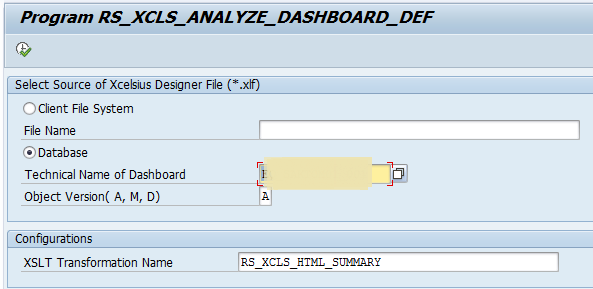
- SAP Community
- Products and Technology
- Technology
- Technology Blogs by SAP
- Connection analysis of Dashboards based on BICS we...
- Subscribe to RSS Feed
- Mark as New
- Mark as Read
- Bookmark
- Subscribe
- Printer Friendly Page
- Report Inappropriate Content
The communication between Dashboards/Dashboards/Xcelsius and BW is handled by BICS remote web service. At design time the web service provides query information and stores the dashboard on the BW server. At runtime, the BEx Web runtime provides a link to the SWF file representing the dashboard. The SWF file is loaded by the browser and it calls the web service that provides the BW query data (and master data) in an XML format. The web service accesses the query data via BICS (BI Consumer Services).
The overall architecture consists of three major building blocks:
- The Dashboards/Xcelsius standalone tool
- The BI Java Stack or Business Objects Enterprise (envisioned in a second step)
- The SAP ABAP Stack

Dashboards/Xcelsius reuses the BEx Analyzer Open/Save Dialogs which communicate with the SAP BW via the RFC protocol. Over these dialogs it is possible to browse for queries and to store the dashboard.
The dashboard consists of three components. The XLF file which represents the dashboard source, the SWF which is the Runtime version and the TXT that externalizes all texts which later on need to be translated. In addition to this also references to bound DataProvider objects over various BI query connections need to be stored. The reason of this is to find all dependent objects when for example one object is moved to another system.
During the design of a dashboard that uses the BI query connection the user gets help about the contained characteristics in a query. This information is obtained via the BICS Web Service that is based on HTTP/SOAP. Logon data needs to be passed to the Web Service in order to connect the ABAP backend.
Within the BICS there is a part that controls and manages the data access and a part that provides the possibility to browse for BI objects like queries, key figures and so on – the BICS Object Services. The BICS Object Services part is not used at DesignTime due to project time constraints. Nonetheless that part is needed at Runtime to deliver the Launcher. BICS uses the JCO to communicate with ABAP.

In the ABAP backend the OLAP processor provides the data and the TLOGO framework provides transport facilities. The dashboard can either be saved in the ABAP stack or in the local file system. Texts that are marked for translation are always stored in the ABAP stack.
Advantages of this integration are as follows:
- Makes it possible to consume SAP BW data within Dashboards/Xcelsius in an easy and comparable workflow as already existing for other data sources.
- Model the Xcelsius dashboard as TLOGO object that it can be transported in the Abap system landscape.
- Connect the existing backend translation workflow with the dashboard to provide locale specific presentations for text and data.
Design time analysis for these dashboards can be done in the BW backend. Without the dashboard designer client tool, basic information like connections and UI components used in the dashboard can be obtained directly from the backend.
1. Run ST13 transaction and run ‘BW-TOOLS’

2. Select Dashboard analysis radio button and hit run

3. Enter technical name for dashboard or choose local XLF file:

Export the report in HTML or other available formats. This file will contain the design time properties of the dashboard:

- SAP Managed Tags:
- BW (SAP Business Warehouse)
You must be a registered user to add a comment. If you've already registered, sign in. Otherwise, register and sign in.
-
ABAP CDS Views - CDC (Change Data Capture)
2 -
AI
1 -
Analyze Workload Data
1 -
BTP
1 -
Business and IT Integration
2 -
Business application stu
1 -
Business Technology Platform
1 -
Business Trends
1,658 -
Business Trends
93 -
CAP
1 -
cf
1 -
Cloud Foundry
1 -
Confluent
1 -
Customer COE Basics and Fundamentals
1 -
Customer COE Latest and Greatest
3 -
Customer Data Browser app
1 -
Data Analysis Tool
1 -
data migration
1 -
data transfer
1 -
Datasphere
2 -
Event Information
1,400 -
Event Information
66 -
Expert
1 -
Expert Insights
177 -
Expert Insights
299 -
General
1 -
Google cloud
1 -
Google Next'24
1 -
Kafka
1 -
Life at SAP
780 -
Life at SAP
13 -
Migrate your Data App
1 -
MTA
1 -
Network Performance Analysis
1 -
NodeJS
1 -
PDF
1 -
POC
1 -
Product Updates
4,577 -
Product Updates
345 -
Replication Flow
1 -
RisewithSAP
1 -
SAP BTP
1 -
SAP BTP Cloud Foundry
1 -
SAP Cloud ALM
1 -
SAP Cloud Application Programming Model
1 -
SAP Datasphere
2 -
SAP S4HANA Cloud
1 -
SAP S4HANA Migration Cockpit
1 -
Technology Updates
6,873 -
Technology Updates
427 -
Workload Fluctuations
1
- Consuming SAP with SAP Build Apps - Mobile Apps for iOS and Android in Technology Blogs by SAP
- Exploring Integration Options in SAP Datasphere with the focus on using SAP extractors - Part II in Technology Blogs by SAP
- FAQ for C4C Certificate Renewal in Technology Blogs by SAP
- Mistral gagnant. Mistral AI and SAP Kyma serverless. in Technology Blogs by SAP
- 10+ ways to reshape your SAP landscape with SAP Business Technology Platform - Blog 5 in Technology Blogs by SAP
| User | Count |
|---|---|
| 40 | |
| 25 | |
| 17 | |
| 14 | |
| 8 | |
| 7 | |
| 7 | |
| 7 | |
| 6 | |
| 6 |